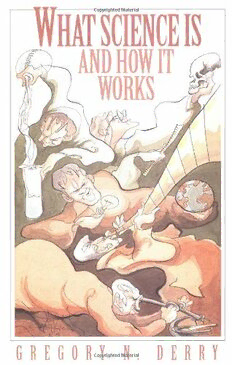Table Of ContentWHAT SCIENCE IS
AND HOW IT WORKS
This page intentionally left blank
WHAT SCIENCE IS
AND HOW IT WORKS
GREGORY N. DERRY
PRINCETON UNIVERSITY PRESS
PRINCETON, NEW JERSEY
Copyright1999byPrincetonUniversityPress
PublishedbyPrincetonUniversityPress,41WilliamStreet,
Princeton,NewJersey08540
IntheUnitedKingdom:PrincetonUniversityPress,
Chichester,WestSussex
AllRightsReserved.
LibraryofCongressCataloging-in-PublicationData
Derry,GregoryNeil,1952–
Whatscienceisandhowitworks/
GregoryN.Derry.
p. cm.
Includesbibliographicalreferencesandindex.
ISBN0-691-05877-6(cloth:alk.paper)
1.Science. I.Title.
Q158.5.D47 1999 500—dc21 99-17186 CIP
ThisbookhasbeencomposedinSabon
Thepaperusedinthispublicationmeetstheminimumrequirements
ofANSI/NISOZ39.48-1992(R1997)(PermanenceofPaper)
http://pup.princeton.edu
PrintedintheUnitedStatesofAmerica
10 9 8 7 6 5 4 3 2 1
Disclaimer:
Some images in the original version of this book are not
available for inclusion in the eBook.
To Paula and Rebecca
This page intentionally left blank
CONTENTS
PREFACE ix
PROLOGUE
WhatIsScience? 3
PARTI.EXPLORINGTHEFRONTIERSOFSCIENCE:
HOWNEWDISCOVERIESAREMADEINTHESCIENCES 9
CHAPTER1
ABird’sEyeView:TheManyRoutestoScientificDiscovery 11
CHAPTER2
Nature’sJigsaw:LookingforPatternsAsaKeytoDiscovery 26
CHAPTER3
NewVistas:ExpandingOurWorldwithInstrumentation 35
CHAPTER4
Close,ButNoCigar:DiscrepanciesAsaTriggertoDiscovery 42
CHAPTER5
IngredientsforaRevolution:ThematicImagination,Precise
Measurements,andtheMotionsofthePlanets 52
PARTII.MENTALTACTICS:SOMEDISTINCTIVELY
SCIENTIFICAPPROACHESTOTHEWORLD 67
CHAPTER6
AUniverseinaBottle:Models,Modeling,andSuccessive
Approximation 69
CHAPTER7
ThinkingStraight:Evidence,Reason,andCriticalEvaluation 89
CHAPTER8
TheNumbersGame:UsesofQuantitativeReasoning 107
PARTIII.LARGERQUESTIONS:THECONTEXT
OFSCIENCE 123
CHAPTER9
UltimateQuestions:ScienceandReligion 125
viii CONTENTS
CHAPTER10
MorePracticalQuestions:ScienceandSociety 133
CHAPTER11
DifficultandImportantQuestions:Science,Values,andEthics 145
CHAPTER12
QuestionsofAuthenticity:Science,Pseudoscience,and
HowtoTelltheDifference 158
CHAPTER13
ContentiousQuestions:TheShadowyBorderlandsofScience 174
CHAPTER14
VeryAbstractQuestions:ThePhilosophyofScience 189
CHAPTER15
QuestionsofLegitimacy:ThePostmodernCritiqueofScience 207
PARTIV.COMMONGROUND:SOMEUNIFYINGCONCEPTS
INTHESCIENCES 215
CHAPTER16
FleasandGiants:SomeFascinatingInsightsaboutArea,
Volume,andSize 217
CHAPTER17
TheEdgeoftheAbyss:OrderandDisorderintheUniverse 230
CHAPTER18
RidingBlake’sTiger:SymmetryinScience,Art,andMathematics 252
CHAPTER19
TheStraightandNarrow:LinearDependenceintheSciences 274
CHAPTER20
TheLimitsofthePossible:ExponentialGrowthandDecay 285
CHAPTER21
IntheLoop:Feedback,Homeostasis,andCybernetics 295
EPILOGUE
So,WhatIsScience? 303
INDEX 305
PREFACE
S
CIENCE,likemanyothertopics,ismuchmoreinterestingifitmakes
sense to you. I wrote this book because science is extraordinarily
interestingtome,andIwanttosharethatinterestwithotherpeople.
Mygoalforthebookistoconveythefoundationsofmyownunderstand-
ing of science, which I have acquired over an extended period of time.
Scholarsargueoverwhetherscienceisabodyofknowledge,acollection
of techniques, a social and intellectual process, a way of knowing, a
strictlydefinedmethod,andsoforth.Theseargumentsarenotveryinter-
estingtome,sinceIacceptalloftheseelementsasvalidpartialvisionsof
science.Inoneguiseoranother,theyallappearsomewhereinthebook.
Myothermotivationforwritingthebookistoshowthatscience,aswell
as being interesting, is also important. A significant part of our culture,
our economy, and our environment are entangled with science in pro-
foundways.Tocomprehendtheworldweliveinwithoutsomegraspof
scienceisdifficult.Crucialissuesareatstake,andtheseissuesrequirean
understandingofscienceinordertoapproachthemintelligently.
The audience for this book is anybody with some curiosity about the
issuesIexplore.Noparticularbackgroundisassumed.Inwriting,Iespe-
cially had in mind a reader who enjoys ideas but hasn’t studied the sci-
encesinanydepth.Peoplewhohaveascientificbackgroundwillalsofind
the book of interest, but I primarily had in mind people who are not
experts. In fact, my underlying assumption is that you don’t need any
particular expertise to have a genuine understanding of what science is
andhowscienceworks.
Inordertokeepthescopeofthebookmanageable,Iamusingtheword
“science” to mean natural science. (This is merely a convenient conven-
tion, not intended to reflect any opinion about the relative worth of the
disciplinesI’mnotincluding.)Thesocialsciences,mathematics,andengi-
neering are sometimes discussed briefly, but the main focus of the book
is on chemistry, biology, physics, and the earth sciences. I have tried to
avoidanyprejudiceinfavorofaparticulardiscipline.Ihavealsotriedto
avoid favoring either the laboratory sciences or the historical/observa-
tional sciences. My own background is in physics, and that may have
coloredmytreatmentandchoiceoftopics.Nevertheless,I havetriedto
maintainabroadtransdisciplinaryflavor.
Anumberofbooksalreadytrytoexplainsciencetothegeneralpublic.
IwouldliketoarticulatewhyIhavewrittenanotheroneandwhywhat
Ihavetriedtoaccomplishisdifferent.Myoverarchinggoalistogivethe
readermorethanjustadescriptionofhowotherpeople(scientists)think

